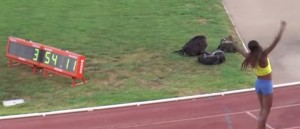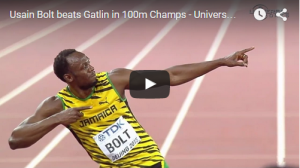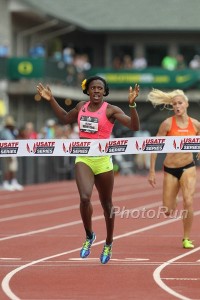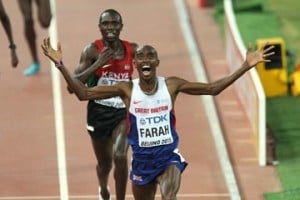Jonathan Gault’s 2015: Kipchoge’s 2:04:00 Without Insoles, Dibaba’s 3:50:07, Bolt > Gatlin, The Greatness of Montaño, Symmonds, Farah and Cheserek
by: Jonathan Gault, LetsRun.com
December 31, 2015
It’s the end of 2015 and that means it is time to look back. LRC staff writer Jonathan Gault shares his thoughts below. LRC’s Robert Johnson shares his thoughts here and Weldon Johnson his here.
WTF Moment of the Year: Eliud Kipchoge Wins the Berlin Marathon in 2:04:00 With His Insoles Falling Out
I spent about a week trying to wrap my mind around this story and then gave up trying to figure it out. Before the 2015 Berlin Marathon, I didn’t even know that it was possible for a runner’s insoles to flap around without actually falling out of the shoe. I’m still convinced Kipchoge broke about seven laws of physics on that day. I get that insoles can be loose, and I get that you can remove them. But how they slipped under the soles of Kipchoge’s feet and out the back of his shoe while he was running — and how they remained there for the rest of the race, rather than falling out entirely — has still not been explained to me.
The fact that Kipchoge was able to complete a marathon in this fashion (his left insole slipped out during the first mile, his right insole by 10k) was incredibly impressive. There’s a reason shoes have insoles — the stuff underneath isn’t particularly comfortable. At the end of the race, Kipchoge’s feet were sore, blistered and bleeding, but that did not deter his competitive spirit.
“I had pain in my foot, but what could I do?” Kipchoge told Runner’s World. “I had to finish the race.”
But Kipchoge did way more than complete the 2015 Berlin Marathon — he won the race handily, posting the fastest time of the year (2:04:00). And that raised a whole new round of questions for me. Have I been overrating insoles all my life? How fast would Kipchoge have run if he hadn’t experienced the equipment mishap? How would I even formulate an insoles-to-non-insoles conversion chart?
There’s still plenty about this story I don’t understand, but two things are clear to me:
- Eliud Kipchoge is the world’s best marathoner
- Eliud Kipchoge is tough as nails
Performance of the Year: Genzebe Dibaba’s 3:50.07 1500 World Record
Five months have passed and I still can’t believe she did it. 3:50.46 was one of those nonsense times, a record set by a woman I believe to have doped. I’d always thought of the “real” world record as residing somewhere in the 3:55-3:56 range. I had written off anyone running 3:50 in the next 20 years.
And then Dibaba ran her 3:54.11 in Barcelona on July 8. “Wow,” I thought, “that’s the performance of a lifetime.” Little did I know that it was merely a prelude to the most shocking run of the year, her 3:50.07 world record in Monaco nine days later. An incredible run by an incredible athlete, and one that reset what we thought was possible from a women’s 1500-meter runner.
Of course, some people will claim that the only way to beat a doped record is to dope yourself. And I cannot say with certainty that Dibaba is clean. But she has access to the greatest gene pool in women’s distance running; if anyone is capable of running 3:50 clean, it’s her.
Race of the Year: World Championship Men’s 100-Meter Final
In the two years between the 2013 and 2015 World Championships, Usain Bolt and Justin Gatlin, the two best athletes in track and field’s marquee event, the men’s 100 meters, did not race once. With Bolt picking his spots to keep a back injury under control, Gatlin filled the void by dominating the 100 in 2014 and, at age 33, putting together the three fastest times of his career in 2015: 9.74, 9.75 and 9.75.
The storylines as the two headed to the World Championships in Beijing were myriad. Gatlin’s two drug bans — the latter a four-year death sentence from which few expected him to recover — were discussed ad nauseam as he continued to produce eye-popping times. Bolt was viewed as vulnerable, particularly after a sluggish 20.29 200 in New York in June that almost brought his two-year unbeaten streak to an end. Would Gatlin finally topple Bolt in the same stadium in which the latter made his name seven years ago? And if so, what would that mean for track and field, especially after incoming IAAF president Sebastian Coe told the BBC in July, “the sport for all sorts of reasons needs Usain to come through in Beijing”?
As a journalist, all those storylines come with the territory. They’re interesting, and we have to cover them to serve our readers. But at my core, I’m a fan just like everybody else, and as I boarded my flight to Beijing, above all I simply wanted to see a race to determine the fastest man alive. It was Usain Bolt, in the Bird’s Nest, with everyone was counting him out, trying to win one more title in a race the world had waited two years to see. No matter what happened, it was going to be pretty cool.
Bolt truly is larger than life, the type of mythical figure I’ll tell my grandkids about one day. I had never seen Bolt in person before and made special note to pay close attention to every one of his races at Worlds. When you watch someone like that, you have to savor every moment. I know he said he’s not retiring until 2017, but nothing in the future is guaranteed — he could develop an injury and never race again. And so I noticed when Bolt stumbled out of the blocks in his semifinal and ran 9.96, minutes before Gatlin cruised through with a 9.77. And I noticed the atmosphere building in the arena as the final approached, like the growl of an oncoming storm. And I certainly noticed the roar of the crowd as Bolt was introduced before the final.
If you’re reading this article, I don’t need to explain why the race itself was great. Strip out names and identities and the essential elements of the race were inherently dramatic: Gatlin jumped out to the lead, strained to hold it as Bolt closed him down and broke form just a hair too early, arms flailing as Bolt streaked past him for the win.
But the scene that sticks out to me from that night was not the race; it was its aftermath. To me, it seemed as if Bolt had draped a blanket of happiness over the stadium, in much the same way he draped the Jamaican flag over his shoulders for his victory lap. Bolt had accomplished what every fan in the stadium was there to see him do and, knowing the degree to which he was adored, he circled the track slowly to offer each spectator a glimpse. As he did so, “One Love” by Bob Marley began to play through the speakers. I smiled. The lyrics, to me, were perfect, an embodiment of the communal joy felt by the crowd, stirred by the brilliance of one man:
One love! One heart!
Let’s get together and feel all right.
Story of the Year: Drugs, Drugs, Drugs
It couldn’t be anything else, could it?
We all recognize that drugs in our sport are a problem, and never has that been clearer than now after a tumultuous year for the sport. One of America’s top coaches, Alberto Salazar, was alleged to have broken drug rules. The Sunday Times and German television network ARD revealed a massive list of suspicious blood values that suggested the drug problem at the sport’s highest level was far more serious than anyone thought. The All-Russia Athletic Federation was revealed to have systematically doped scores of athletes, and Russia has since been suspended from international competition.
And while I’m simultaneously encouraged (by athletes and whistleblowers willing to speak out when they see something wrong) and discouraged (by the potential scope of the doping problem), what troubles me the most is that there is no endgame in the war on performance-enhancing drugs. For starters, the line between which substances should be banned and which ones should not is blurry and will always be a matter of opinion. The WADA prohibited list determines what pros can or cannot put in their body, but that list changes every year. Obviously there are some drugs that everyone agrees should be banned: anabolic steroids, EPO. But every athlete has to perform an ethical cost-benefit analysis when taking a supplement or drug of any kind. Am I okay with this? Two athletes may have a different answer to the same question.
The larger problem, however, is that even if society could somehow reach a consensus on exactly what should be banned, it’s impossible to know with 100% certainty who is clean and who is not. The toothpaste is out of the tube: drugs exist and testing will never be perfect. So every fan has to decide for themselves whether what they’re witnessing is genuine, and that sort of decisionmaking can rip enjoyment from the sport.
One of the things I love most about sports is the finality they provide. There’s a winner and there’s a loser. Teams and individuals all chase after the same goals and the ones that come out on top get to call themselves champion. Track and field is the purest of them all. Who’s the best runner? The one who makes it to the finish line first. Who’s the best jumper? The one who jumps the farthest. Clean. Simple. Elegant.
Drugs screw all of that up. They clutter what should be definitive results pages with mental asterisks and question marks. When I watch a tremendous race, I shouldn’t have to think “Was anyone in that field doped?” But I do, and it sucks.
And even if the sport gets its act together, I just don’t see a scenario in which that question goes away. Perhaps it becomes a smaller concern, the 10th question I ask myself instead of the first. But the war on PEDs is not a game that can be won; a referee can’t blow his whistle and end the match. No matter how good the testing gets, there will always be doubt. And that really sucks.
Comebacks of the Year: Nick Symmonds and Alysia Montaño
I’m a sucker for a transcendent talent getting knocked down before climbing the mountain one more time. Symmonds lost 2014 to injury, Montaño to pregnancy, but the veterans showed the skills that made them great by returning to the top in 2015 and securing memorable wins in the 800 at USA Outdoors, the sixth title for each of them.
Upset of the Year: Syracuse over Colorado at NCAA XC
This wasn’t the biggest upset of the year, but it was the most memorable. Syracuse went into NCAAs as one of the top teams in the country, but needed a perfect race to topple the big dogs, Stanford and Colorado. As it turns out, the Orange did run a perfect race, putting three men in the top nine and getting a heroic run from fourth man Philo Germano (39th). The drama of seeing both teams tied at 99 points with 2k to go was exceeded only by the sheer joy of the Syracuse runners as they found out they were victorious. A truly great race produces more than one team worthy of becoming champions, and Colorado, led by the tenacious Pierce Murphy (3rd overall), was more than deserving of winning its third straight national title. But Syracuse was better, and the result was the school’s first national title since 1951.
Routine Greatness of the Year: Edward Cheserek and Mo Farah
These guys are so good that nothing they do surprises me anymore. Farah ran a 3:28 1500 in July and then runs a 59:22 half marathon two months later? Of course he did, he’s Mo Farah. Cheserek closed the last 1k of his NCAA indoor mile title in 2:19 the day after anchoring the Oregon DMR to a win? Of course he did, he’s Edward Cheserek.
You can call their dominance boring, but it’s still dominance, and for that, they should be appreciated.
More 2015 in Review:
*Rojo: 2015 The Year of Corruption, Plus the Domination of the Men’s Stars, and the Emergence of Eric Jenkins and Emily Sisson
*Wejo: Tsepo Mathibelle Athlete of Year, Evan Jager’s 8:00 Steeple Race of Year, Plus Unknown Person of Year & 1 Regret







